Western dressage is hot. It’s showing up at events around the country, where riders enjoy the ability to be judged while riding a standardized “test,” or pattern, which calls for precision, balance, and rhythm at the walk, jog, and lope.
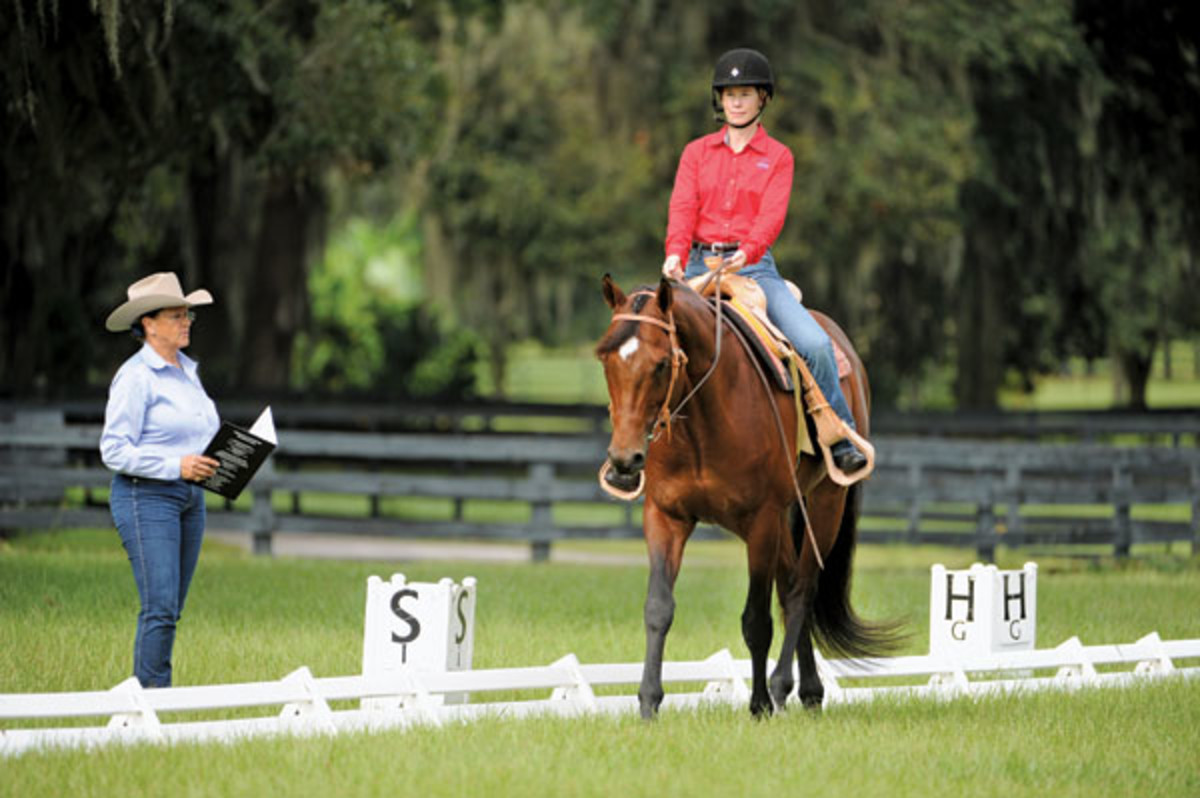
What separates it from “regular” dressage? You get to ride in Western tack and attire rather than the typical English equipment. You’ll ride with a rein in each hand (two-handed), for direct-rein control, and with light, elastic contact to your horse’s mouth.
I’ve been teaching dressage to Western riders for years, because it’s the basis of good riding in any discipline. The term “dressage” actually means training of animals. But to me, it’s also about communication. With it, you develop a way to “talk” to your horse in terms he can understand. The more dressage you do, the larger your vocabulary.
Eventually you can ask him to do anything: go slow or fast, put his head down or up, hold his body straight or move his shoulders or hips to one side or the other, gallop down a hill, do a rollback…you name it! My bet is that you’ll love the control you’ll net once you try dressage.
To get you hooked, I’ll talk you through a real Western dressage test. Your goal: to flow seamlessly through the maneuvers, with rhythmic gaits, precise transitions, and accurate maneuvers.
Sure, it’s designed to challenge you, but you’ll find using the letters (which act as markers) in a dressage arena will help you ride with the required precision.
Western dressage is open to any breed. I love Quarter Horses because of their quiet temperaments and forgiving natures, so we’ll demonstrate this test aboard Larks Home Run, a Quarter Horse gelding owned by Dr. Elizabeth Stauber-Johnson, and ridden by Marie-Frances Davis.
Let’s Ride
We’ll use United States Equestrian Federation Western Dressage Primary Level, Test 1 (which has since been updated; go to usef.org for the latest tests). For information on finding current tests, and about Western dressage in general, see “The World of Western Dressage,” on page 51.
WD Tip: If you want to show, but worry about forgetting parts of a test, don’t panic: You can have someone call the test to you as you ride, as I’m doing for Marie-Frances on pages 46 and 47. With repetition, you’ll learn to memorize it, and won’t need a “caller.”
This test is divided into 12 sections, each of which calls for different maneuvers. I’ll break each section down for you, step by step. Helmets are optional, but suggested.
1. A: Enter working jog. X: Halt, salute. Proceed working jog.

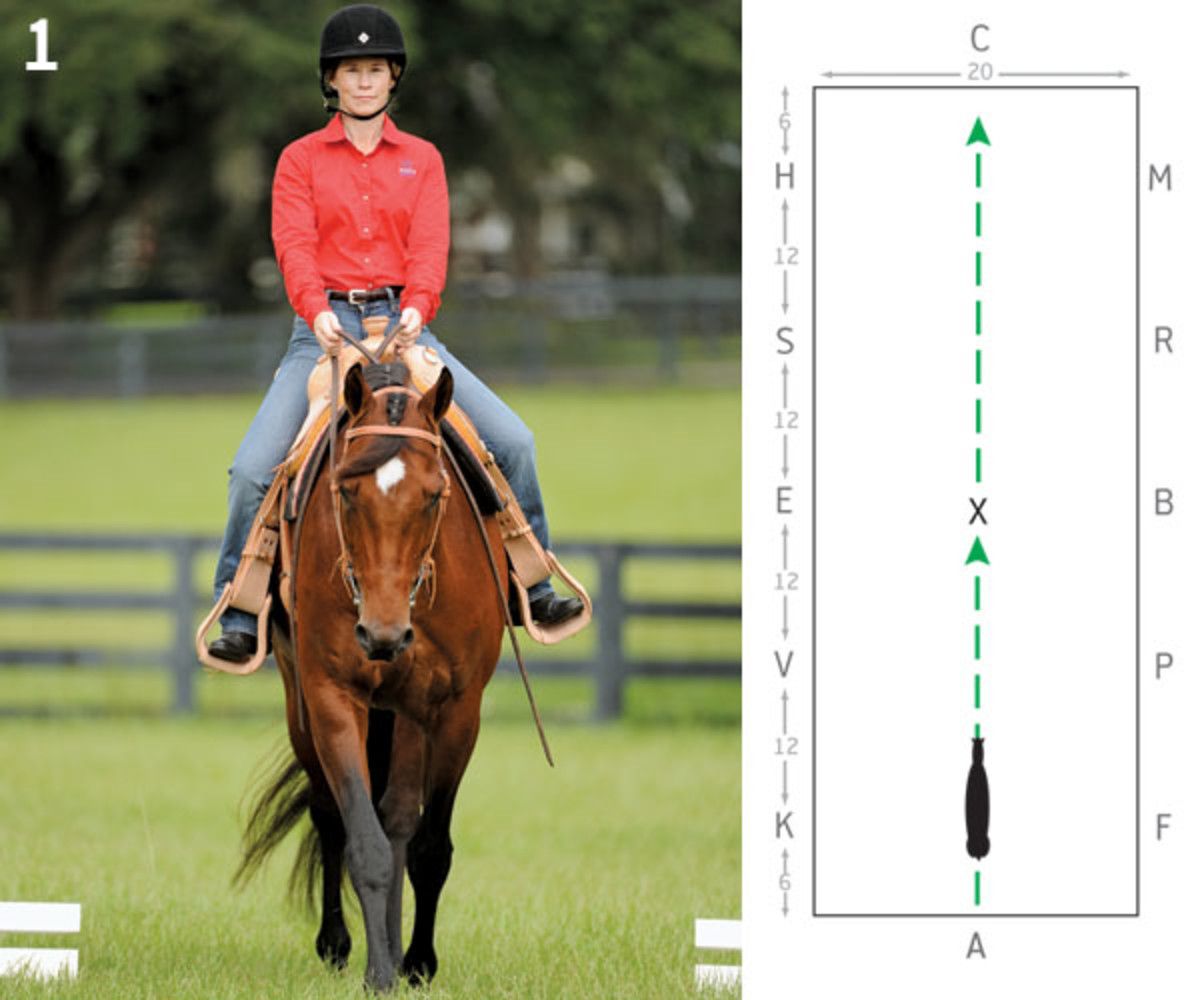
Warm up your horse. When you’re ready to ride the test, circle him in his best direction just outside the entry to the ring, at the letter A. (See diagram, at right.) Establish an active, steady working jog. (See “Western Dressage Glossary,” on page 49, for a description of gaits.)
When you’re ready to enter, turn toward the imaginary center line (which runs lengthwise down the ring, between A and C, where a judge would sit). Then enter the ring down that center line maintaining the working jog.
WD Tip: When you make the turn from your circle toward A to make your entrance, look down the center line to C. That’s going to help you stay straight.
Transition from jog to walk (only a step or so), to halt at X, by pushing down with your seat, keeping both legs on your horse, and closing your fingers. Keep his body straight on the center line; that’s how you get a “square” halt, meaning his front and hind legs are under his body and evenly spaced, indicating balance. (If you show, judges will reward a square halt.)
WD Tip: Use your peripheral vision to watch for E and B. When you can no longer see those letters, you’re at X. It usually takes at least 10 to 12 feet for your horse to process transition cues, depending on his responsiveness. Since his shoulder should be on top of X when you halt, plan your transition aids accordingly.
When you feel your horse is settled in the halt, salute the imaginary judge. Here’s how.
Women: Put both reins in your left hand. Move your right hand (with your fingers pointed down) to your side behind your right thigh. At the same time, nod your head down and up.
Men: Take your hat off and make the same movement with your arm.
WD Tip: If you show, the judge will nod back. Be sure to make eye contact; that shows confidence.
Now pick up your right rein and continue the test. For the upward transition to a working jog, push your horse forward with your seat first, then press with your legs…but be light with them. If you start kicking, he may resist or jump forward, ruining the smooth flow of your test.
Keep him straight, by maintaining even rein contact on both sides of his neck. Prepare to track to the right at C, by flexing your horse’s head to the right a stride or two before you reach that marker.
2. C: Track right. B: Circle right 20 meters.
3. Between F & A: Develop working lope right lead.
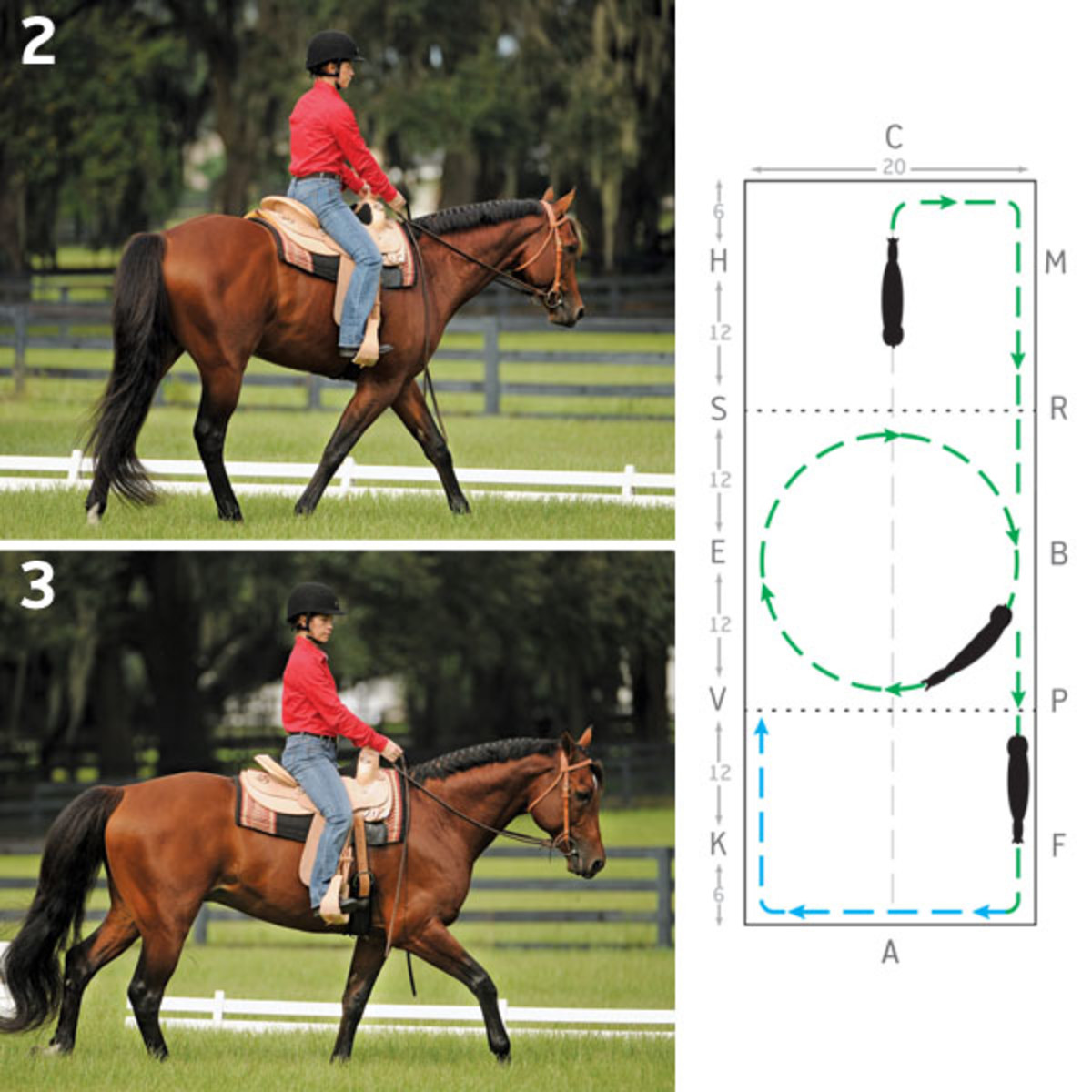
When you track right at C, use your inside rein to flex your horse rightward, and your inside leg to keep him bending (and from falling into the turn). Use your outside rein to keep him from over-flexing, and your outside leg to maintain the working jog’s rhythm.
WD Tip: I see lots of riders tilt forward or lean to the inside around corners. To prevent this, keep your shoulders back, which will help you balance and keep you positioned over your horse’s center of gravity. That, in turn, will help him stay balanced and engaged in his hindquarters.
As you head down the long side toward B, count a one-two, metronome-like rhythm in your head, so your horse’s working jog remains cadenced. As you approach B, slightly flex his head to the right to prepare to guide him onto the 20-meter circle. (That’s about 65½ feet.)
WD Tip: To ride an accurate 20-meter circle, you’ll track about 6 feet inside an imaginary line between V and P, and S and R. To help keep it round, mentally divide the circle into four quarters. Here’s how: When you reach B, look to the imaginary center line, 6 feet inward from the imaginary line between V and P. Before you get to the center line, look for E. Then, before you get to E, look for the center line 6 feet in from the line between S and R. When you reach the center line, look for B. Be sure to take a deep breath so you don’t hurry the last quarter (a common mistake).
As you finish the circle by approaching B, use your inside leg and outside rein to straighten your horse down the long side. Then working jog straight toward P. When you get there, prepare for the right-lead working lope departure so when you reach F, you’re ready to bend him around the corner and ask for it, using your seat and outside leg.
WD Tip: When you ask for a lope departure in a corner, your horse can easily lean inward. Be sure to use your inside leg and outside rein to help keep his body upright and balanced through the corner and transition.
4. E: Circle right 20 meters.
5. H: Working jog. C: Medium walk.
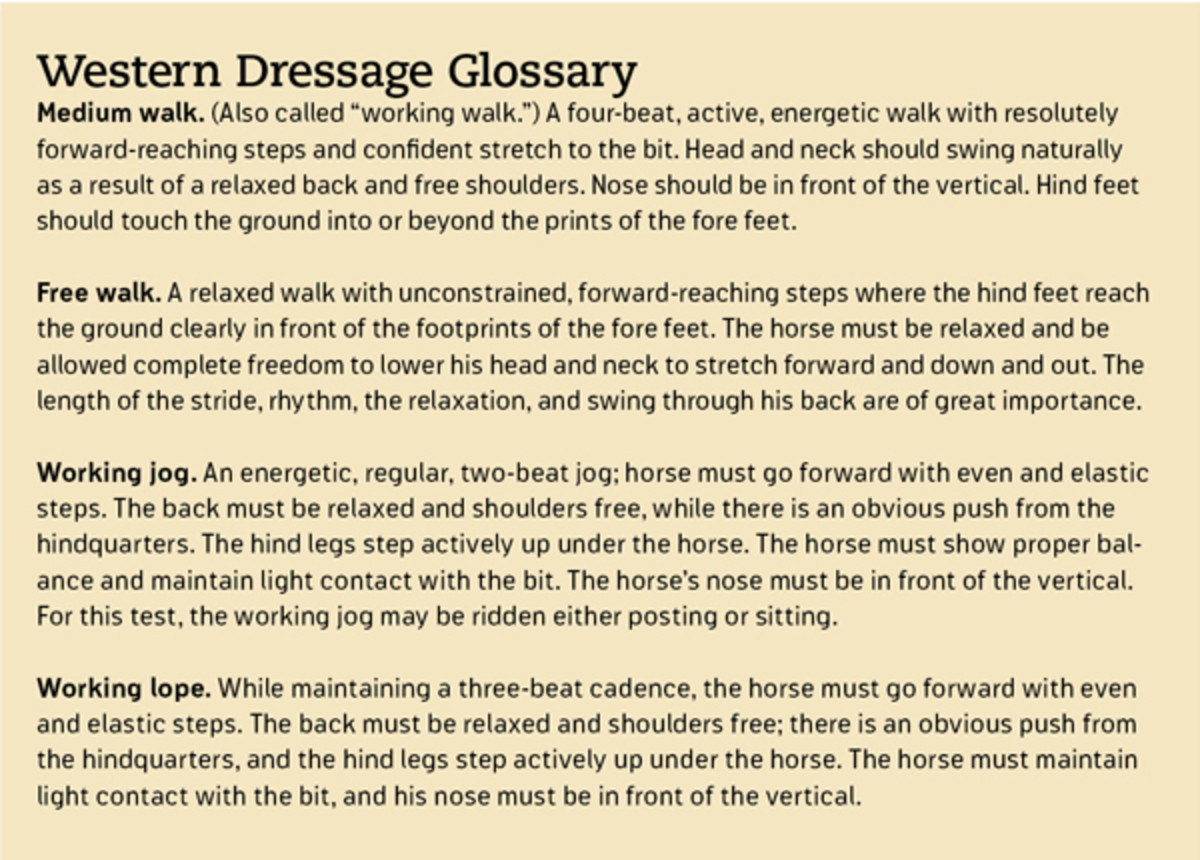
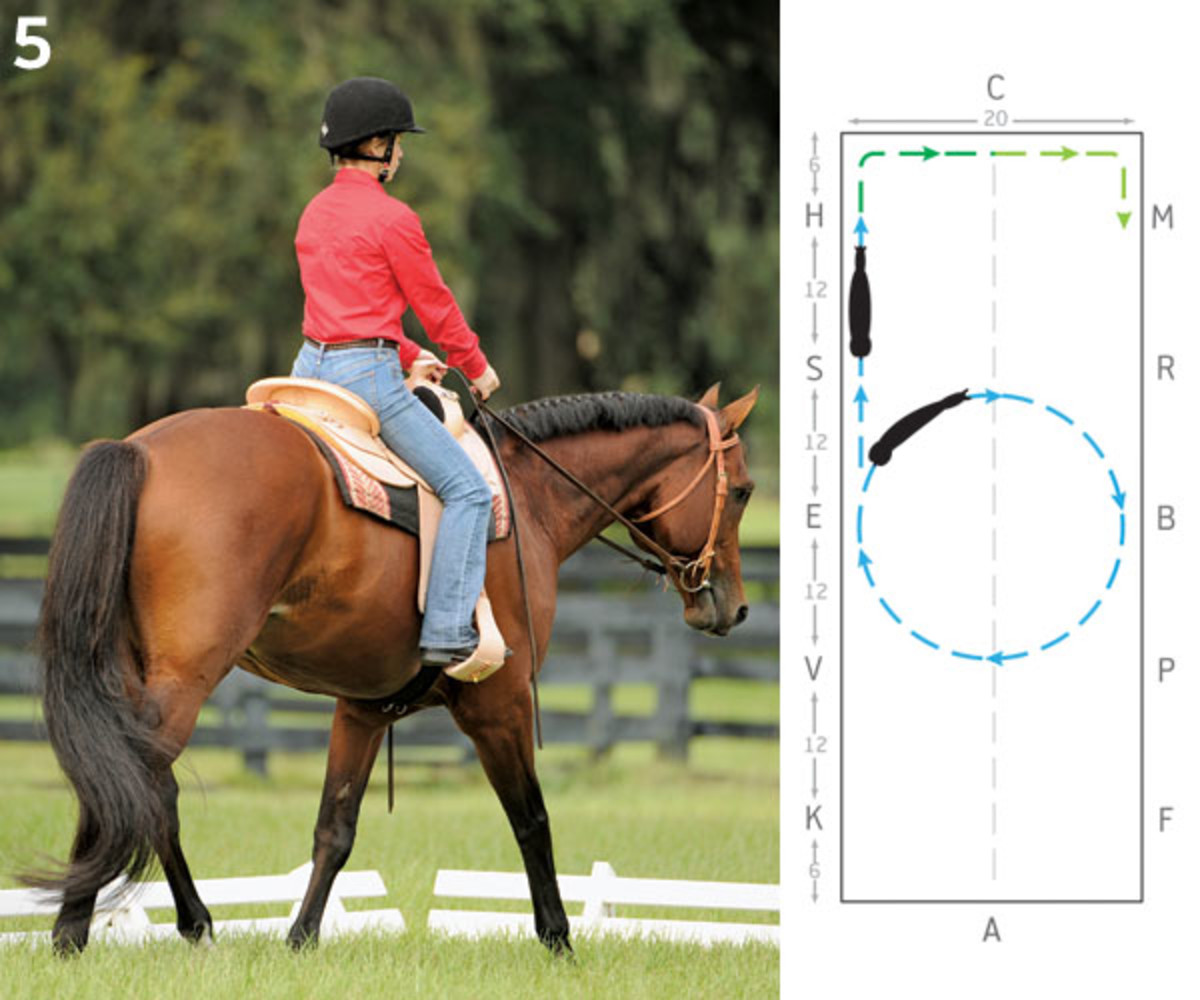
As you lope past A and reach K, straighten your horse. He should have a forward “bounce” to his lope, with his forehand higher than his hind end, which indicates he’s pushing from his hindquarters. This is especially true for Quarter Horses, which tend to have a naturally low head carriage.
WD Tip: To get this “uphill bounce,” use your seat and legs to encourage “forward!” while slightly lifting your fingers to encourage him to elevate his forehand. (If you were to lose contact, he’d flatten his body, dumping his weight onto his forehand, which could cause him to lose rhythm and balance.)
At E, lope a 20-meter circle, maintaining that uphill balance.
Straighten your horse as you exit the circle at E. Prepare for a downward transition to a working jog at H. Immediately prepare for the downward transition to the medium walk, at C. Sit tall and tighten your stomach. Have your hips stop moving with the jog rhythm while your legs maintain light contact with your horse’s sides. Then simply close your fingers to ask him to walk.
6. MXK: Free walk.
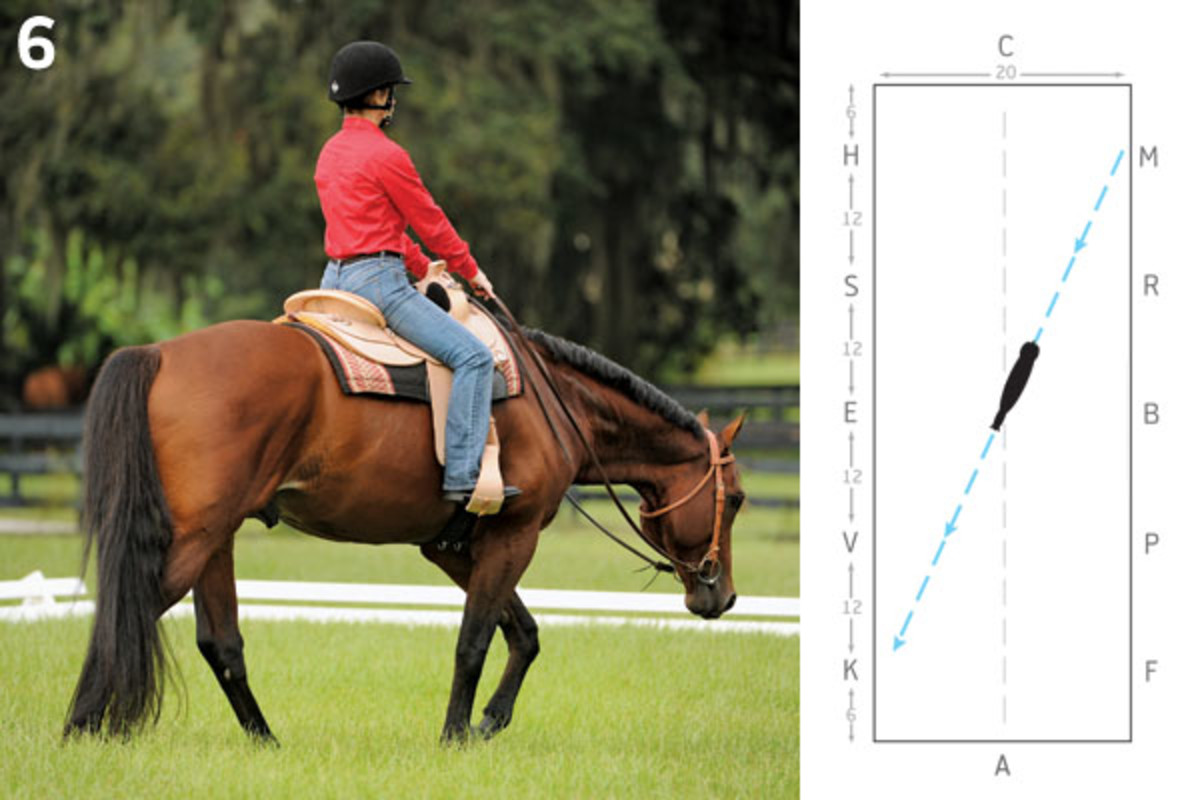
Maintain your medium walk to the right, through the corner between C and M. When you reach M, loosen your reins to allow your horse to stretch his neck forward, down, and out (which stretches his back) as you free walk across the diagonal toward K. Be sure to gently drive him forward with your seat. Keep your legs against his sides, to encourage his hind-end engagement and maintain his rhythm and straightness.
WD Tip: Most horses tend to relax in the free walk. It’s as if they say, “Ah, that stretch feels so good!” When you’re schooling, include frequent free-walk breaks. Not only will they allow your horse to stretch and relax before you collect him again, but you’ll also have the opportunity to practice this movement frequently. That’s a good thing, since it earns you double points when you show using this test.
Re-establish contact as you approach K. Adjust your reins slowly and softly to prepare for the upcoming transition to a medium walk. As you gather your reins, maintain your leg and seat aids. Your horse should show acceptance of the bit without changing his rhythm.
7. K: Medium walk.
A: Working jog.
8. B: Circle left 20 meters.
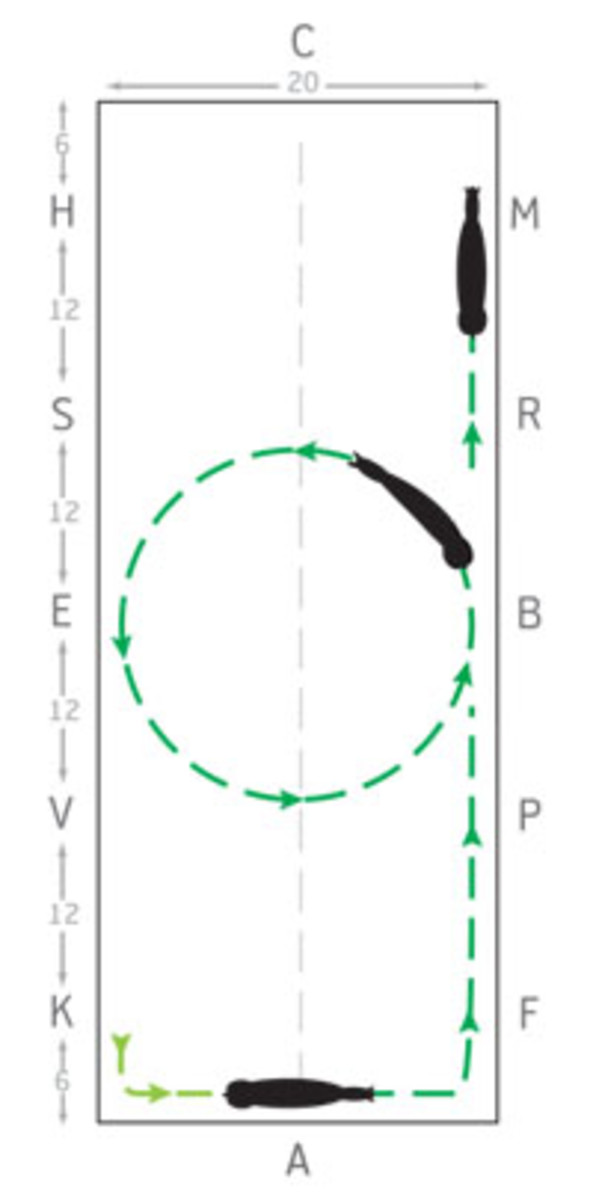
By the time you reach K, you should have light contact with your horse’s mouth and a rhythmic medium walk. Between K and A, bend your horse to the left; ask for the working jog at A.
Guide him down the long side to B, then start your 20-meter circle to the left. This and the rest of the movements on this test will mirror those that you’ve just completed to the right. Simply reverse the previous instructions to perform the movements to the left.
9. Between M & C: Develop working lope left lead.
10. E: Circle left 20 meters.
11. K: Working jog.
Properly bend your horse to the left on the corner between M and C, so he’s balanced for the lope departure there. And, be accurate with your departure—make the transition right in the middle of that curve. Ride the circle to the left the same way you did to the right. At K, ask your horse for the working jog.
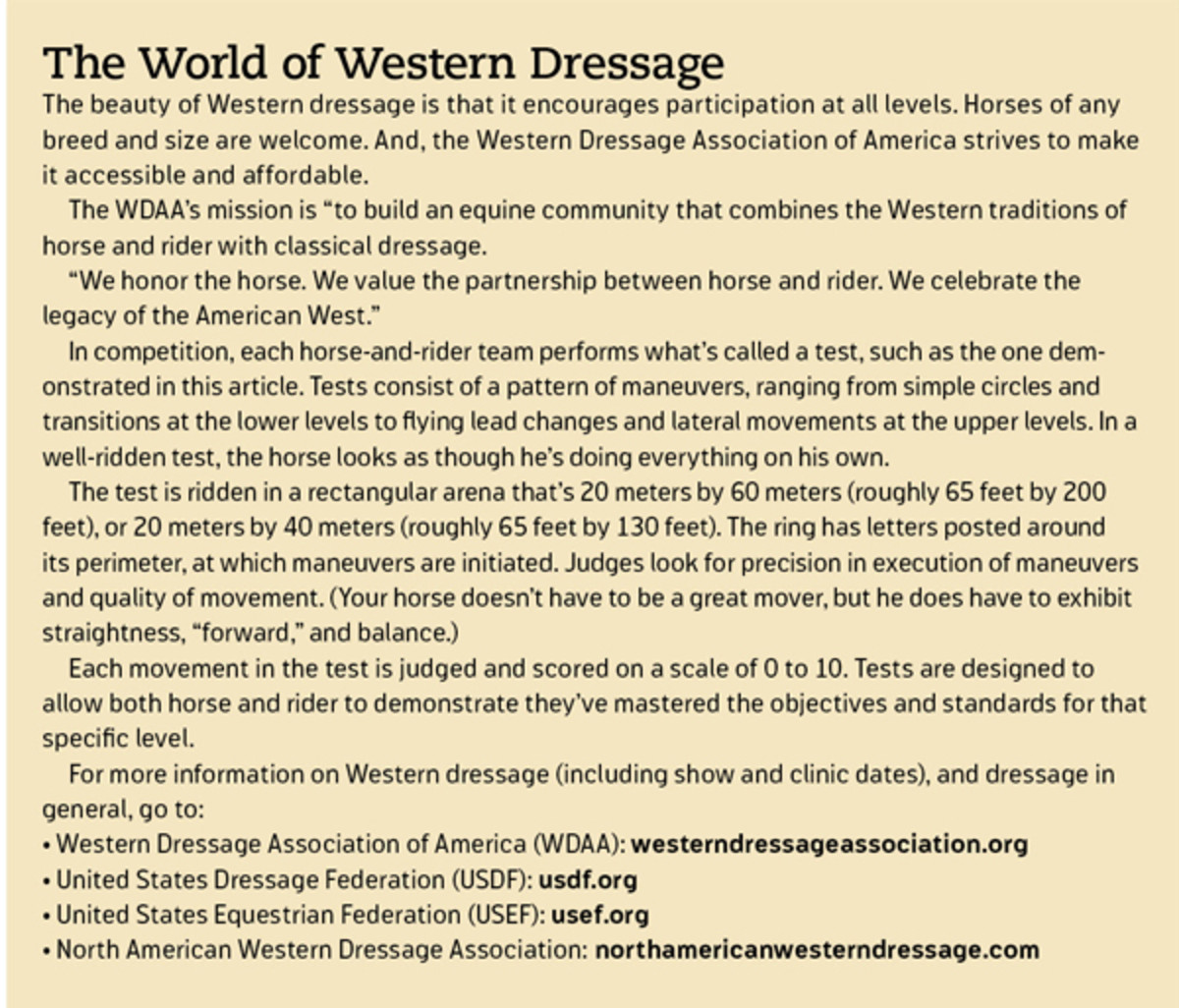
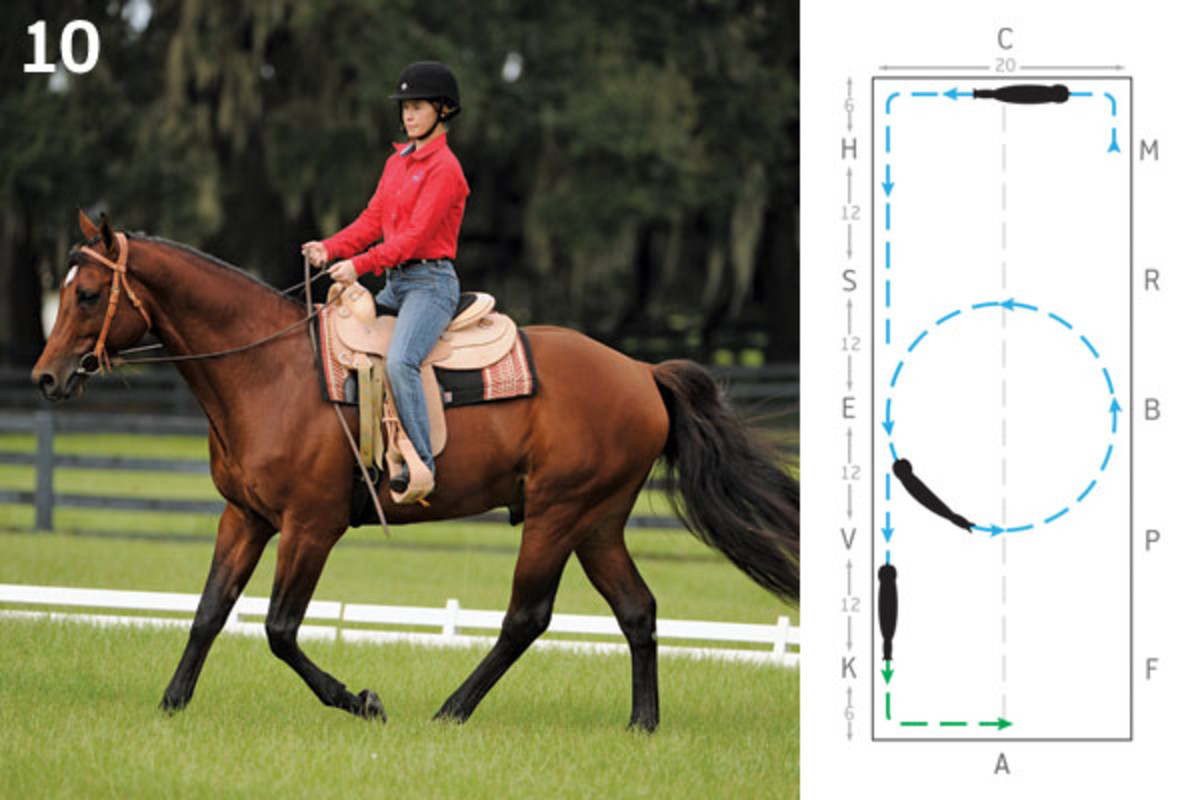
12. A: Down center line.
X: Halt, salute.
Just past K (in the middle of the corner), turn your head and look for C, then turn toward it. If you were to look at A, you’d under- or overshoot the center line. During this turn, be sure to keep your shoulders back and your horse balanced; it’s the tightest turn you’ll ride on the test.
As you approach X, softly transition down to the walk for a step or two, then halt. If your horse doesn’t stop square over all four legs (you’ll feel his legs splayed beneath you), take a step forward, to square him up.
Then salute. After the imaginary judge salutes back, drop your reins and walk toward C in a free walk. (At a show, you’d give the real judge a verbal thank you.) You’re then free to exit the ring. Pat your horse, to thank him for a job well done. And give yourself a pat on the back. Good job!
Lynn Palm began teaching Western dressage long before it became a familiar term, and she’s on the board of directors of the Western Dressage Association of America. She rode some of the great Rugged Lark’s sons, My Royal Lark, The Larks Ascending, and Larks Home Run, to multiple championships in United States Dressage Federation competition and continues to teach Western dressage at her Palm Partnership Training schools and at clinics and expos. Lynn also is a regular commentator for HRTV. She and her husband, horseman Cyril Pittion-Rossillon, have facilities in Ocala, Florida, and Bessemer, Michigan.






